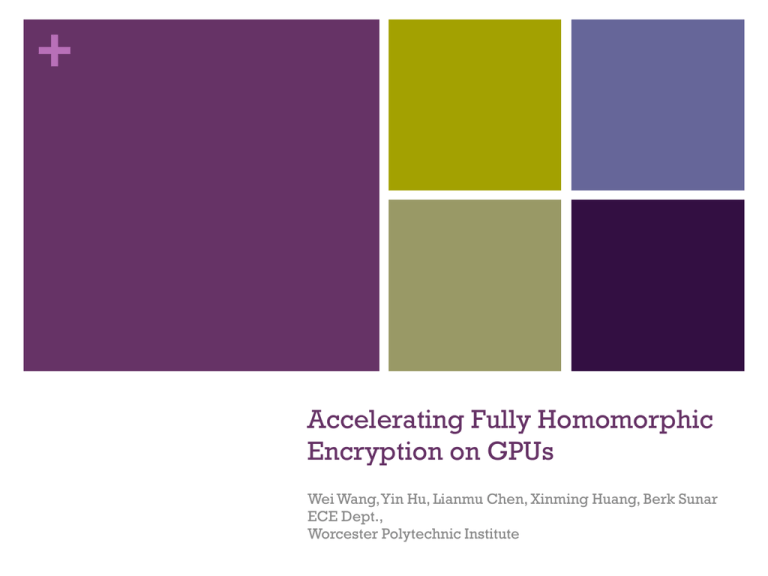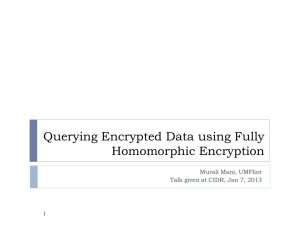
+
Accelerating Fully Homomorphic
Encryption on GPUs
Wei Wang, Yin Hu, Lianmu Chen, Xinming Huang, Berk Sunar
ECE Dept.,
Worcester Polytechnic Institute
+
Fully Homomorphic Encryption
Introduced
by Gentry in 2009
Powerful!
Arbitrary depth circuits evaluated on fixed sized
ciphertexts
Impractical, for
now..
Very Slow (~30 sec for reencryption)
Large Public Keys (100’s Mbytes)
Lampson (CryptDB): “I don’t think we’ll see anyone using
Gentry’s solution in our lifetimes.” (Forbes, Dec 2011)
+
If history teaches us anything..
RSA was introduced in 1978
Intel 8086 was introduced 4-10 Mhz
1024-RSA enc. would take at least 10 minutes (est.)
RSA circuit layed out in MIT basketball court (Shamir & Rivest)
+
Today
RSA
is used in >90% of secure connections
(Intel Whitepaper)
Runs
in ~100’s msec on cell phones
Moore’s
Law and algorithmic improvements!
Question:
Can we expect the same for FHE?
+
What is FHE?
A Fully homomorphic encryption scheme refers to a form of
encryption which support both addition and multiplication to
be carried out on the ciphertext and obtain and encrypted
result which is the ciphertext of the result of operations
performed on the plaintext.
𝐸 𝑥1 ∗ 𝐸 𝑥2 = 𝐸 𝑥1 ∗ 𝑥2
𝐸 𝑥1 + 𝐸 𝑥2 = 𝐸 𝑥1 + 𝑥2
+
The Gentry-Halevi FHE Scheme
Key Generation: The key Generation procedure generates
the public and private keys required for encryption,
decryption and recryption. It can be executed offline.
Encryption: To encrypt a bit b ∈ 0,1 with a public key 𝑑, 𝑟 .
𝑛−1
𝑐= 𝑢 𝑟
𝑑
𝑢𝑖 𝑟 𝑖
= 𝑏+2
𝑖=1
𝑑
Decryption: The encrypted bit b can be recovered by
computing
𝑚 = 𝑐 ∗ 𝑤 𝑑 𝑚𝑜𝑑 2
+
The Gentry-Halevi FHE Scheme
Recrypt: The homomorphic decryption of the ciphertext.
The private key is divided into 𝑠 pieces that satisfy 𝑠 𝑤𝑖 = 𝑤.
Each 𝑤𝑖 is further expressed as 𝑤𝑖 = 𝑥𝑖 𝑅𝑙𝑖 𝑚𝑜𝑑 𝑑, where 𝑅 is
some constant, 𝑥𝑖 is random and as 𝑙𝑖 ∈ 1,2, … , 𝑆 is also
random. The recryption process can then be expressed as:
m= 𝑐 ∗ 𝑤
𝑑
𝑚𝑜𝑑 2 = [
𝑆 𝑐𝑥𝑖 𝑅
𝑙𝑖
]𝑑
The Recrypt process can then be divided into two parts.
First, compute the sum of 𝑐𝑥𝑖 𝑅𝑙𝑖 for each “block” 𝑖. To further
optimize this process, encode 𝑙𝑖 to a 0-1 vector
(𝑖)
(𝑖)
(𝑖)
𝜂1 , 𝜂2 , … , 𝜂𝑛
where only two elements are “1” and all
others are “0”. We can alternatively obtain 𝑐𝑥𝑖 𝑅𝑙𝑖 from
𝑙𝑖
𝑐𝑥𝑖 𝑅 =
𝜂𝑎
𝑎
(𝑖)
𝜂𝑏
𝑏
(𝑖)
𝑐𝑥𝑖 𝑅𝑙(𝑎,𝑏)
+
Parameters of Gentry’s
Homomorphic Scheme
Dimension
d
Encrypt
Decrypt
Recrypt
512
195764
0.19 sec
---
6 sec
2048
785006
1.8 sec
0.02 sec
32 sec
8192
3148249
19 sec
0.13 sec
2.8 min
32768
12628800
3 min
0.66 sec
31 min
Gentry’s implementation was running on an IBM System
x3500 server, featuring a 64-bit quad-core Intel Xeon
E5450 processor, running at 3GHz, with 12 MB L2 cache
and 24GB of RAM.
+
CPU vs. GPU Hardware
GPUs are ideal for FHE
Multiple ALUs
Fast onboard memory
High throughput on parallel tasks
+
Fast Multiplications on GPUs
The Strassen FFT Multiplication Algorithm
Emmart and Weem’s Implementation on GPU
They perform the FFT in finite field Z/pZ with a prime
p=0xFFFFFFFF00000001, which belongs to Solinas Primes.
Solinas Primes support high efficient modulo computations. In
addition, and improved version of Bailey’s FFT technique is
employed to compute the large size FFT.
+
Fast Multiplications on GPUs
CPU
GPU
Intel Xeon X5650
processor running at
2.67GHz with 24GB RAM
Build with NTL/GMP
NVIDIA Tesla C2050,
448 CUDA cores,
1.15 GHz, 3GB
GDDR5* memory
1024 x 1024
8.1 ms
0.765 ms
2048 x 2048
18.8 ms
1.483 ms
4094 x 4096
42.0 ms
3.201 ms
Size in K bits
+
Modular Multiplication
Barrett Modular Multiplication
Barrett modular multiplication computes 𝑟 = 𝑎𝑏 𝑚𝑜𝑑 𝑀,
when giving three positive integers 𝑎, 𝑏 and 𝑀.
Input: positive integers
𝑎, 𝑏, 𝑀, 𝑞 =
𝑙𝑜𝑔2𝑀
,µ =
2𝑞
𝑀
Output: r = 𝑎𝑏 𝑚𝑜𝑑 𝑚
1: t ← 𝑎𝑏.
2: 𝑟 ← t − M 𝑡µ/2𝑞 .
While 𝑟 ≥ 𝑀 do 𝑟 ← 𝑟 − 𝑀
Return 𝑟
+
GPU Implementation of FHE
The Decrypt process
The most computationintensive part is the largenumber modular multiplication.
Applying the FFT based
Strassen algorithm and Barrett
reduction results significant
speedup.
+
GPU Implementation of FHE
Implementing Encrypt
For the Encrypt process, the most complex operation is the
evaluation of the degree-(n-1) polynomial. In the GentryHalevi implementation, a recursive approach is applied.
In our implementation, we apply the sliding window
technique to compute the polynomial evaluations. Suppose the
window size is 𝑤 and we need t = 𝑛/𝑤 windows, so we have
𝑢𝑖 𝑟
𝑖
=
𝑡−1
𝑗=0
𝑟
𝑤∗𝑗
∗
𝑤−1
𝑖=0
(𝑢𝑖+𝑤𝑗 𝑟 𝑖 ) .
We can precompute 𝑟 𝑖 , 𝑖 = 0,1, … , 𝑤. These precomputed
values can be pre-loaded into GPU memory before the Encrypt
process starts. In our implementation, we choose the window
size 𝑤=64.
+
GPU Implementation of FHE
Implementing Recrypt
The Recrypt process is much more complicated. Recrypt
process can be divided into tow parts: process S blocks
separately and then sum them up. For the process block, the
most time consuming computation is in the form of
𝑐𝑥𝑖
𝑅𝑙𝑖
=
𝜂𝑎
𝑎
(𝑖)
𝜂𝑏
(𝑖)
𝑐𝑥𝑖 𝑅𝑙(𝑎,𝑏)
𝑏
We refer to 𝑐𝑥𝑖 𝑅𝑙(𝑎,𝑏) for each iteration as factor. In each
iteration, we compute factor=factor*R mod d. R is a small
constant, so the CPU is used to compute the new factor while
GPU is busy computing the addition from last iteration.
After processing all the “blocks”, we can sum these partial
results using the grade-school addition in Gentry-Halevi
implementation.
Performance FHE Primitives
*Based on small setting (dimension n=2048).
CPU
GPU
Intel Xeon X5650
processor running at
2.67GHz with 24GB RAM
Build with NTL/GMP
NVIDIA Tesla C2050,
448 CUDA cores,
1.15 GHz, 3GB
GDDR5* memory
Encryption
1.69 sec
0.22 msec
x7.7
Decryption
18.5 msec
2.5 msec
x7.5
Recryption
27.68 sec
4.2 sec
x6.6
Platform
Speedup
+
Thanks!









